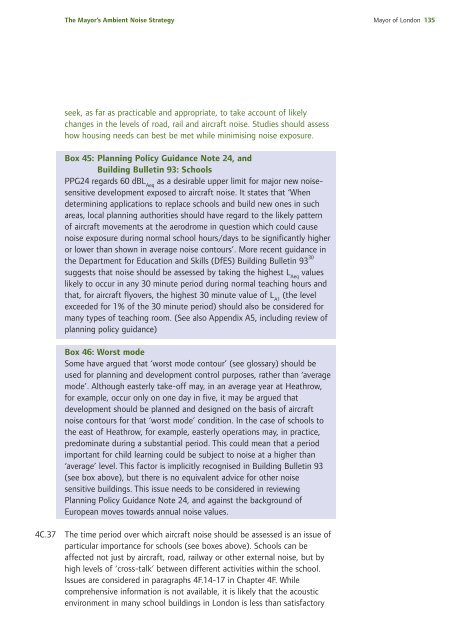The Mayor's Ambient Noise Strategy - Greater London Authority
The Mayor's Ambient Noise Strategy - Greater London Authority
The Mayor's Ambient Noise Strategy - Greater London Authority
You also want an ePaper? Increase the reach of your titles
YUMPU automatically turns print PDFs into web optimized ePapers that Google loves.
<strong>The</strong> Mayor’s <strong>Ambient</strong> <strong>Noise</strong> <strong>Strategy</strong> Mayor of <strong>London</strong> 135<br />
seek, as far as practicable and appropriate, to take account of likely<br />
changes in the levels of road, rail and aircraft noise. Studies should assess<br />
how housing needs can best be met while minimising noise exposure.<br />
Box 45: Planning Policy Guidance Note 24, and<br />
Building Bulletin 93: Schools<br />
PPG24 regards 60 dBL Aeq<br />
as a desirable upper limit for major new noisesensitive<br />
development exposed to aircraft noise. It states that ‘When<br />
determining applications to replace schools and build new ones in such<br />
areas, local planning authorities should have regard to the likely pattern<br />
of aircraft movements at the aerodrome in question which could cause<br />
noise exposure during normal school hours/days to be significantly higher<br />
or lower than shown in average noise contours’. More recent guidance in<br />
the Department for Education and Skills (DfES) Building Bulletin 93 30<br />
suggests that noise should be assessed by taking the highest L Aeq<br />
values<br />
likely to occur in any 30 minute period during normal teaching hours and<br />
that, for aircraft flyovers, the highest 30 minute value of L A1<br />
(the level<br />
exceeded for 1% of the 30 minute period) should also be considered for<br />
many types of teaching room. (See also Appendix A5, including review of<br />
planning policy guidance)<br />
Box 46: Worst mode<br />
Some have argued that ‘worst mode contour’ (see glossary) should be<br />
used for planning and development control purposes, rather than ‘average<br />
mode’. Although easterly take-off may, in an average year at Heathrow,<br />
for example, occur only on one day in five, it may be argued that<br />
development should be planned and designed on the basis of aircraft<br />
noise contours for that ‘worst mode’ condition. In the case of schools to<br />
the east of Heathrow, for example, easterly operations may, in practice,<br />
predominate during a substantial period. This could mean that a period<br />
important for child learning could be subject to noise at a higher than<br />
‘average’ level. This factor is implicitly recognised in Building Bulletin 93<br />
(see box above), but there is no equivalent advice for other noise<br />
sensitive buildings. This issue needs to be considered in reviewing<br />
Planning Policy Guidance Note 24, and against the background of<br />
European moves towards annual noise values.<br />
4C.37 <strong>The</strong> time period over which aircraft noise should be assessed is an issue of<br />
particular importance for schools (see boxes above). Schools can be<br />
affected not just by aircraft, road, railway or other external noise, but by<br />
high levels of ‘cross-talk’ between different activities within the school.<br />
Issues are considered in paragraphs 4F.14-17 in Chapter 4F. While<br />
comprehensive information is not available, it is likely that the acoustic<br />
environment in many school buildings in <strong>London</strong> is less than satisfactory
















